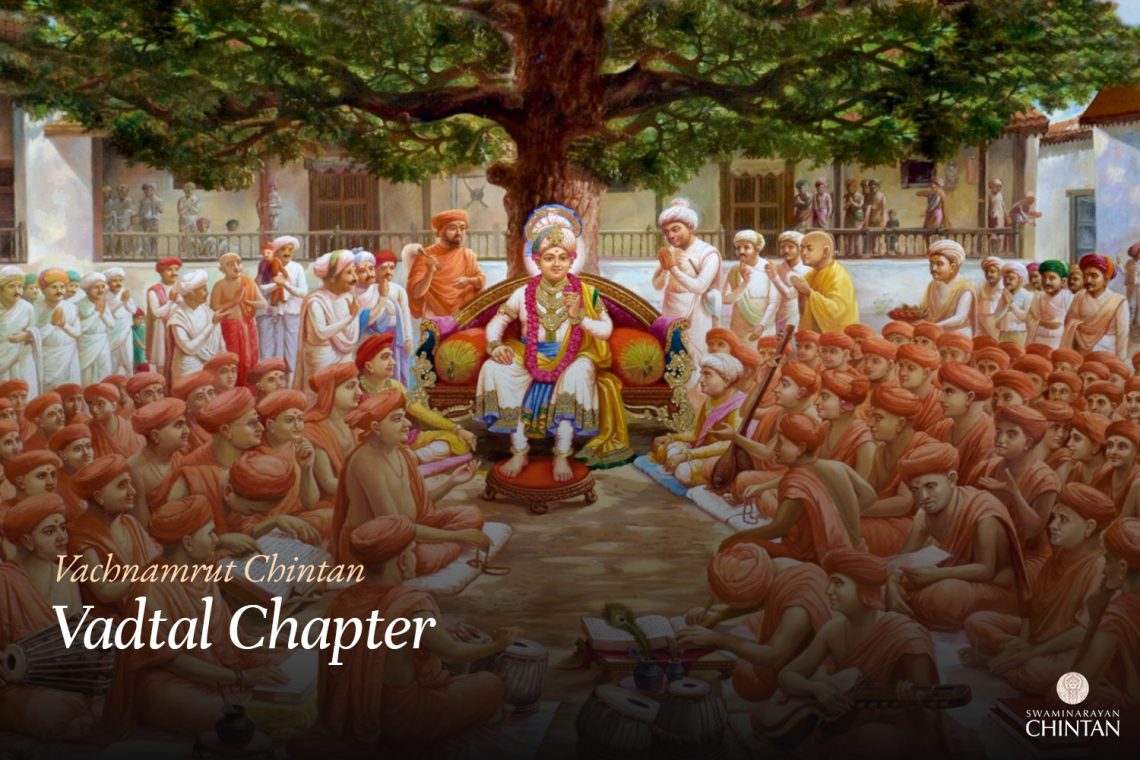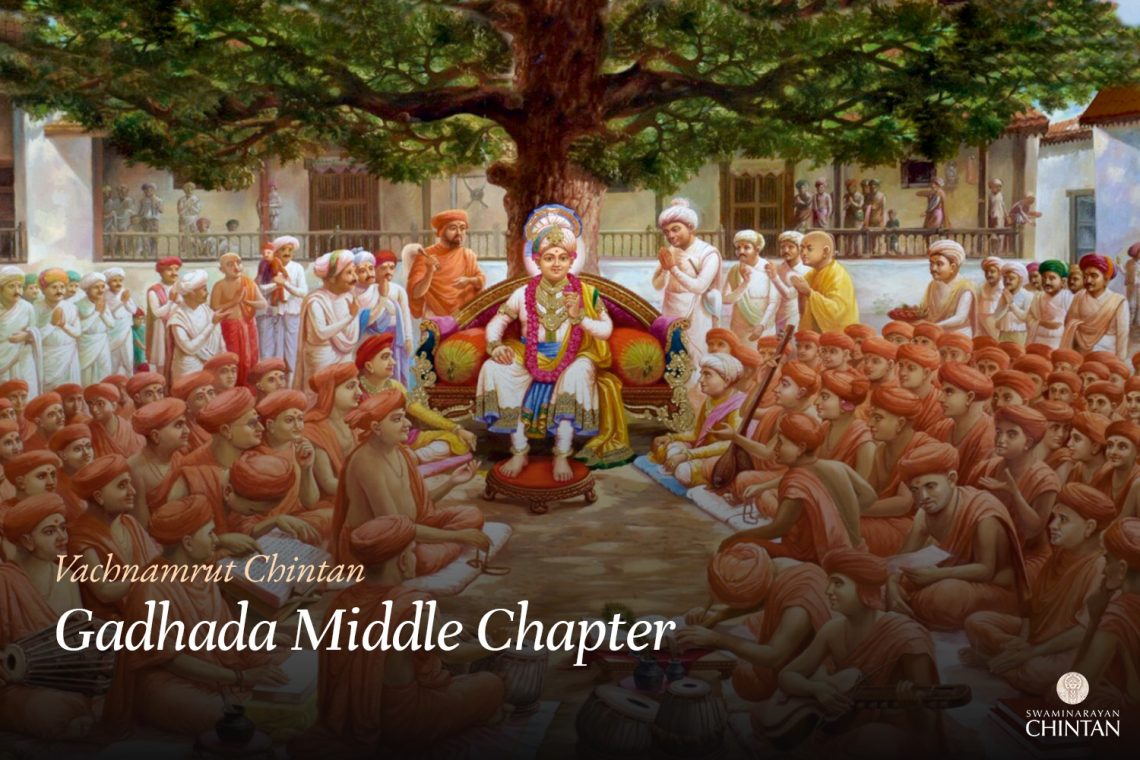Central Insights: Key Points: Explanation: Maharaj, after deep contemplation, cast a compassionate glance upon the devotees and spoke, “Today, I wish to speak on the topic of Nishchay in God. Listen attentively. Purushottam Bhagwan resides eternally in Akshardham, which radiates with the brilliance of countless suns, moons, and fires. He…
Browsing CategoryVachanamrut Chintan
GM-50 The Secret Principle; Worldly Attachment
Central Insights: Key Points: Explanation: In this Vachanamrut, Shriji Maharaj states that today he wants to reveal a secret about his life to all his devotees. Just as rivers merge into the sea, just as a faithful wife and a butterfly both sacrifice themselves to fire, and just as a…
V-20 The Understanding of King Janak
Central Insights: Key Points: Explanation: In this Vachanamrut, Shreeji Maharaj asks the paramhansas a question. He explains that rajogun (passion and activity) is the source of lust, while tamogun (darkness and ignorance) is the source of anger and greed. He then poses a question: What is the one method by…
V–19 On Becoming a Devotee and the Comparison of One Who Desires Material Happiness to a Worm of Filth
Central Insights: Key Points: Explanation: In this Vachanamrut, Maharaj speaks kindly to devotees, explaining that whenever a soul takes birth in Bharatkhand (India) in human form, it is certain that an incarnation of Bhagwan or a Sadhu will be present on Earth. If that soul becomes aware of this truth,…
V-18 Things That Must Be Understood
Central Insights: Key Points: Explanation: In this Vachanamrut, Shreeji Maharaj first posed a question to the senior Paramhansas: “What are the teachings a Satsangi (member of the holy fellowship) must necessarily know?” He then answered Himself, explaining that one must know the customs of our Uddhav Sampraday (the religious fellowship…
V–17 An Enlightened Person Has Conquered His Senses
Central Insights: Key Points: Explanation: In this Vachanamrut, Shreeji Maharaj asks a question: “The five cognitive senses and five conative senses are aware of their respective sensory objects. Both a man of knowledge and one of ignorance use their senses in the same way. However, the senses of the man…
V-16 Not Feeling Comfortable with Worldly Great Men
Central Insights: Key Points: Explanation: This Vachanamrut is a discourse on Maharaj’s confidential principle. During the assembly, a Shastri (scholar) from Vadodara was seated. He expressed to Maharaj, “Maharaj, if you were to display a miracle to a prominent person, then they would greatly assist in expanding Satsang. You have…
V-15 The Cause of Divine and Demonic Nature
Central Insights: Key Points: Explanation: In this Vachanamrut, Shobharam Shastri posed a question to Maharaj: “Maharaj, are the two types of souls—divine and demonic—eternal, or have they come to be as a result of certain circumstances?” Maharaj replied, “In this universe, there exist two types of souls—daivi and asuri. In…
V-14 Whom a Non-believer Considers a Sinner Is Not a Sinner, and Whom He Considers to be Sincere in His Dharma Is Not Really So
Central Insights: Key Points: Explanation: In this Vachanamrut, Ramchandraji Vaghmodia of Vadodara posed a question to Shreeji Maharaj, “Maharaj, what is the reason that even an unworthy soul can go into samadhi (trance)?” The background of this question involves an incident: A certain pious person’s life had deteriorated considerably. They…
V-13 If Brahma Pervades, How Can It Possess a Form?
Central Insights: Key Points: Explanation: In this Vachanamrut, Bhagubhai Patidar from Bhadaran asked Maharaj, “How does a person go into samadhi (trance)?” The phrasing of “this” in his question suggests that someone must have recently gone into samadhi after seeing Maharaj. Maharaj replied, “For the welfare of souls, Bhagwan takes…
V-11 The Destruction of the Jeev; Love for the Satpurush Is the Only Means to Realising the Atma
Central Insights: Key Points: Explanation: This Vachanamrut speaks on the destruction of the jeev.Maharaj declares, “My natural is such that I greatly fear causing harm to any of these four: Bhagwan, His Bhakta, a Brahmin, or a poor person. I do not fear anyone else. If anyone harms one of…
V–10 Path to the Soul’s Ultimate Salvation
Central Insights: Key Points: Explanation: In this Vachanamrut, a Patidar named Bhagubhai from the village of Bhadaran asked Maharaj, “Maharaj, how can the jiva (soul) achieve kalyan?” In response, Maharaj explained that when Bhagwan incarnates on Earth, the soul’s kalyan can be attained by taking refuge in Him, surrendering to…
V–09 How Can One Experience the Nirgun Bliss of God?
Central Insights: Key Points: Explanation: In this Vachanamrut, Maharaj poses a question to the assembly of muni (Santos). He inquires why the happiness related to God, which is Nirgun (beyond attributes), is not experienced in the same way as the three types of happiness—Tamasi, Rajasi, and Sattvik—which arise in the…
V-08 The Spider’s Web
Central Insights: Key Points: Explanation: In this Vachanamrut, Maharaj sat for a moment in a meditative posture, gave darshan (a sacred sight), and then began to speak, “Although the Vritti of the eyes is formless, when it encounters a visible object, it becomes fixed upon it. Though the eye is…
V–07 Characteristics of Divine and Demonical Souls, Anvay–Vyatirek
Central Insights: Key Points: Explanation: The devotees were engaged in discussions about Bhagwan, and the topic of divine and demonical souls arose. They discussed how divine souls naturally become devotees of Bhagwan, while demonical souls inevitably turn away from Bhagwan. At that point, Chimanravji asked Maharaj, “Maharaj, is there any…
V-06 Response to Chimnaraavji’s question
Central Insights: Key Points: Explanation: In this Vachanamrut, Chimnaraavji of Vadodara posed a question. “Maharaj, at the time of the first pralaykaal (final dissolution), souls merged into maya while in a karan sharir (causal body). Later, during the period of creation, these souls obtained sthul (gross) and sukshma (subtle) bodies,…
V– 05 Not Perceiving Maya in God, Equal Service
Central Insights: Key Points: Explanation: In this Vachanamrut, Maharaj instructed the assembly to pose challenging and intricate questions. Accordingly, Muktanand Swami asked a question inspired by the verse: दैवी ह्येषा गुणमयी मम माया दुरत्यया।मामेव ये प्रपद्यन्ते मायामेतां तरन्ति तेdaivī hyeṣā guṇamayī mama māyā duratyayā |māmeva ye prapadyante māyām etāṃ taranti…
V-04 The Fountain
Central Insights: Key Points: Explanation: In this Vachanamrut, Muktanand Swami begins by asking a question: “What is the single technique that a devotee, following the path of devotion to Bhagwan, should adopt to encompass all means of spiritual attainment?” Maharaj replies, “The satsang of a Sant endowed with thirty virtues,…
V-03 Four Types of Eminent Spiritual Leaders
Asserted Topics: Key Points: Explanation: In this Vachanamrut, Maharaj directly questioned the leading Santo and devotees regarding the ideal characteristics of a leader in our Uddhav Sampradaya (holy fellowship). He explained that a true Ekantik Bhakt (single-minded devotee) should possess Gnan (knowledge), Vairagya (non-attachment), Dharma (moral integrity), and Bhakti (devotion)…
V-02 Knowing God through the four scriptures
Central Insights: Key Points: Explanation: In this Vachanamrut, Kandas Patel from Buva asks Maharaj, “How does one win the pleasure of God?” In response, Maharaj says, “God is pleased if one does not commit any offense against Him.” One might wonder, what is an offense? To this, Maharaj clarifies that…
V-01 Nirvikalp Samadhi
Central Insights: Key Points: Explanation: In this Vachanamrut, Shobharam Shastri from Vadodara asked Maharaj, “O Maharaj! When a mumukshu (seeker of liberation) attains Nirvikalp Samadhi, they transcend the gunas (attributes of Maya) and become an Ekantik Bhakt (single-minded devotee of God). But what happens to someone who cannot attain Nirvikalp…


